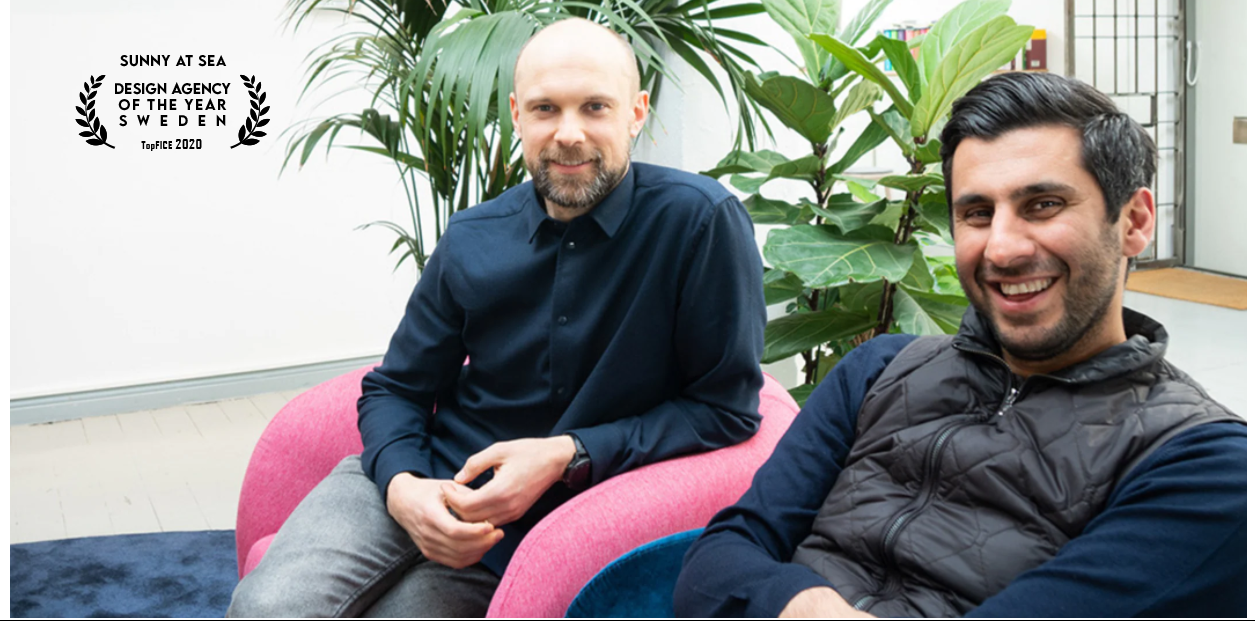Stockholm, Sweden. Johan Wendborg, CEO & Strategy in Sunny at Sea and Farbod Bozorgzad, Account director and founder.
Tomilli: What was the case with which your agency obtained the most awards this year, and which made you the agency of the year according to the TopFICE global ranking? Let’s talk about that case.
We have had several projects that were nominated during the year, but the project that stood out the most was Fading Stories – pass them on. Says Account director and founder Farbod Bozorgzad.
Fading Stories – pass them on was an exhibition at Fotografiska in Stockholm that portrayed 23 survivors of the Holocaust. Fotografiska is the largest photography museum in the world and for the first time they had an exhibition that did not showcase photographs in the physical space, instead the visitors experienced the exhibition through typographic posters.
While the presentation in the physical space was reduced to typographic posters in black and white, photographs and other background information including interviews were accessible via an AR app. Based on quotes from the survivors, the aesthetics of the poster framework were inspired by censured documents with blacked out passages, in order to illustrate how easily stories can be fragmented and corrupted. This demanded the viewers’ attention and thus urged the importance of seeing the full story, to see through “alternative facts”. Technically, the typographical setup of the posters works as a QR code which enables the visitor to use their phone camera to unlock each portrait and view them in the frames. After a portrait is unlocked, the user could access the full story, the survivors’ voice and portrait.
During 2020 the project was awarded Red Dot Grand Prix, Graphic Design winner in the Swedish Design Awards, D&AD Graphite Pencil, Silver in Swedish Guldägget, two-time finalist in ADC Awards.
How to create the best brand experiences?
Sunny at Sea works according to a number of simple rules and principles. Many are self-evident, but we have learned to stick to these simple principles in practical terms. Says Johan Wendborg, CEO and founder.
The first principle is: Do not think industry-specific or target group, think human. The user makes comparisons between different brands across the industry categories, freely. This means that from a brand perspective, the user evaluates, Tesla with Patagonia’s way of communicate on the web, or expressing themselves visual. This is because the user is far from homogeneous, we belong to many different types at the same time. You could resemble it to being able to love luxury restaurants and fine dining while having strong opinions about which fast food chain has the best French fries. In reality this means that, you as a brand, no longer can hide within your category, but must relate to brands in other industries as well and follow the technical development and expression of other industries. To us it sounds obvious, but for many brands this is difficult to implement and they need to rethink how their organization works with marketing and R&D together from the start.
The second principle is that we need to emotionally affect the user. And in order to succeed with that we must express an opinion, take a stand and dare to show a true vision. We often stare blindly at sales or advertising penetration. But an easier way to see its impact is to measure how the brand manages to touch or reach out with its opinions. We usually say that it is always easier to follow someone who actually wants or means something, someone who has an affect on someone. Rather than following the one who is only 100% correct.
If we succeed in getting this far, it is our job to find new communicative expressions to emotional affect through a product, or the way we relate to that product.
Will things no longer be physical or digital?
Both yes and no. Johan continues, there will always be a need for the tactile. But I think users care less and less about the difference between physical and digital because today they are completely dependent on each other. A user experience goes through the physical world to the digital, or vice versa, several times during an experience. It is no longer possible to spend 1000s of hours developing a perfect seat for the car, but neglect with the bug testing or the user experience of the app for the same car. Everything is summed up in a holistic experience of the car you drive. This is something that many brands are still lagging behind in prioritizing. The processes and budgets are in many cases unevenly balanced between the physical and digital experiences, something that is often visible and unfortunately often reduces the overall experience. But there is a huge advantage for the brands that prioritize this more than their competitors. Take a look at banks for instance. Many younger people today choose banks based on which app is best.
How to keep up with the trends?
This is exactly the problem. This is exactly the question many clients ask us. Just when that question is asked, you are a little lost, we think. Because I as a user do not expect my favorite clothing brand, or training watch, or skin care product to follow the trends that are right now. They must dare to create their own paths and expressions for me to follow, which in some cases may create an entire trend. Today, there is a concern that missteps, or less successful expressions, will have major consequences due to the social media climate. And unfortunately, it often inhibits brands to dare to express themselves strongly and convincingly. This means that they secure the message to “fit in and do the right thing”. But then they are suddenly a follower and will not be able to affect people in the same strong way. Which leads to a brand that is ”cooling down”. But the question is still relevant, because I think brands need to get better at keeping up with trends, as I wrote earlier, in categories other than their own, in order to be able to reflect in the next step on how to find a more experimental relationship and dare to test and create your own expressions. It’s better to do something little bit off than not to do it at all. A brand that does not do things does not exist.
Is it difficult to create new trends from advertising?
Yes, we at Sunny at Sea never work with marketing as an isolated channel, we run our clients’ products both inside and outside digital channels, and we work with their entire customers’ experiences in all parts of the brand, app, graphic expression or web. It is enormously daring of a brand to create new trends because it requires a broad work in all channels with a clear strategy and how everything should be expressed in a coherent way in all channels. This is super complex, especially when these parts are run by slightly different departments within their organization. I think we need more strong creative leaders with clear visions for both the client and the agency. I absolutely believe that there is still, among some clients, an overconfidence in the individual effect of advertising. For us at Sunny at Sea, we rarely talk about advertising individually, however, we often talk about advertising as part of a customer’s experience, and then it sometimes has a very important role.
Brands that thrill become immortal, but how do you make your customers feel, and then think?
At Sunny at Sea, we work according to Don’t think – feel. It simply means that, if we create a self experience that is intuitive and simple, we create the opportunity to ementionally influence through design, expression or technology. As long as we make their customers feel something, they will not have to think so much. I will explain a little: We work with the simple principle that the human brain is roughly divided into two parts, an emotional and a rational part. These parts are equally important, but it is only the emotional part that is always involved in all decisions! Always! It is also the part that first “shares” its experience to the more rational part before a decision. So the only thing we need to do is to emotionally affect the user…Then the brand must of course deliver on the product’s expectations and quality. We must
also not forget that a user experience can start anywhere, it is never simple and linear. For some users, it starts where it ends for others. But if we always think – Do not think, Feel. Then we force ourselves to both simplify both an app, or to simplify a product portfolio. So the focus is on feeling and not wondering how things work.
Are consumers getting more emotional?
Yes!
See what is happening in the world today, more and more people are becoming more and more emotional and less rational in their decisions. We believe that it is an effect of lack of time. We have more interests, more and faster news, more and faster updates of, for example, products. This means that the process for our internal evaluation takes less and less time, which leads to the faster emotional brain gaining more and more self-determination, because the emotions are faster than the rational one. This is something that all brands must relate to. It is not enough to “be right” or to have the best product. Your product must “feel right”. This may sound like the same thing, but for us it is two completely different things. We believe in even more emotionally charged brands that dare to express their opinions and dare to choose sides. Something we call Emotional Hypercharged Brands. They become more relevant to some and clearer in their message, but they are of course also rejected by some because of this. This means that it will be even tougher for brands that today place less emphasis on their expression, as they will be perceived as less and less dedicated.





